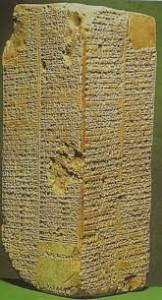The numerous archaeological excavations in the land of “Sumer” have returned a very important document, the Sumerian King List, came to us in sixteen versions. All the tablets are written in Sumerian language, although some have an Akkadian influence, maybe caused by to subsequent revisions. This list records the cities and kings who ruled in the land of Sumer with the duration of their reign. It begins with “the mythical” antediluvian king, whose regal duration was long. This was measured in “sar”, every sar worth 3600 years. Subsequently lists the “historic” rulers and therefore post-diluvian. According to researchers the text was composed towards the end of the third millennium, under the Third Dynasty of Ur, with whom there was a revival of the ancient Sumerian language. The thought that through the flood there inserted into the historical time in our state of “Man” was accepted in Mesopotamia. As evidenced by the text the mythical kings had very long kingdoms, equal to 36,000 years (10 sar) and in the Atra- hasis (the text of the flood) it is declared that only after this disaster the man knew the death. According to this list “kingship descended from heaven”, then for God’s will, initially on Eridu. The power, then, shifted to other cities with their dynasties until to the Flood. After this catastrophe, always by divine will the kingship descended from heaven, this time on Kish and on his 33 rulers. They were followed kingdoms of other Mesopotamian cities (from Uruk to Ur, from Adab Mari) or of Elam (as Awan) until the Akkadian empire. The document of the kings list, according to scholars, is partly true, especially with regard to historical rulers, in fact, archaeological investigations have confirmed some information such as the names of the rulers of Kish. As we mentioned above, the durations of reign of mythical kings are considered fantastic, also unreliable is considered the presentation of some ruling dynasties simultaneously in different centers. Similar documents are the “list of Babylonian kings” and “the list of Assyrian kings” of a later period.
LA LISTA REALE SUMERICA
I numerosi scavi archeologici effettuati nella terra di “Sumer” hanno restituito un documento molto importante, la lista reale sumerica, giuntaci in sedici versioni. Tutte le tavolette sono scritte in sumero, anche se alcune presentano un’influenza accadica, forse dovuta a rielaborazioni successive. La lista registra le città e i re che governarono nella terra di Sumer insieme alla loro durata di regno. Essa inizia con i re “mitici” antidiluviani, la cui durata regale era lunghissima. Questa era misurata in “sar”, ogni sar valeva 3600 anni. Successivamente vengono elencati i sovrani “storici” e dunque post-diluviani. Secondo gli studiosi il testo è stato composto verso la fine del III millennio, sotto la III Dinastia di Ur, con il quale vi fu una ripresa dell’antica lingua sumera. Il pensiero che attraverso il diluvio ci si immetteva nel tempo storico e dunque nella nostra condizione di “Uomo” era accettata in Mesopotamia. Come dimostra il testo i re mitici avevano regni molto lunghi, pari a 36.000 anni (10 sar) e nell’ Atra-hasis (il testo del diluvio) viene affermato che solo dopo tale catastrofe l’uomo conobbe la morte. Secondo questa lista “la regalità discese dal cielo”, dunque per volontà divina, dapprima su Eridu. Il potere, poi, si spostò su altre città con le proprie dinastie fino al Diluvio. Dopo tale catastrofe, sempre per volontà divina, la regalità discese da cielo, questa volta su Kish e sui suoi 33 sovrani. A questi seguirono regni di altre città mesopotamiche (da Uruk ad Ur, da Adab a Mari) o elamiche (come Awan) fino all’impero accadico. Il documento della lista reale, secondo gli studiosi, in parte è veritiero, soprattutto per quanto riguarda i sovrani storici, infatti, le indagini archeologiche hanno confermato alcune notizie come i nomi dei sovrani di Kish. Come abbiamo già detto fantastiche sono ritenute le durate di regno dei re mitici, inoltre poco attendibile è ritenuta la presentazione di alcune dinastie regnanti contemporaneamente su diversi centri. Documenti simili sono la “lista dei re babilonesi” e “la lista dei re assiri” di epoca posteriore.
